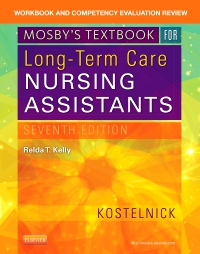
Workbook and Competency Evaluation Review for Mosby's Textbook for Long-Term Care Nursing Assistants - Elsevier eBook on VitalSource, 7th Edition
Elsevier eBook on VitalSource

Give your students a complete study guide and certification review in one book with the Workbook and Competency Evaluation Review for Mosby's Textbook for Long-Term Care Nursing Assistants, 7th Edition. Engaging review questions, exercises, and independent learning activities go beyond the textbook and build critical thinking skills to prepare students for their certification exam and clinical practice.
Newer Edition Available
Workbook and Competency Evaluation Review for Mosby's Textbook for Long-Term Care Nursing Assistants - Elsevier eBook on VitalSource
-
- A variety of activities and exercises including multiple-choice questions, matching, true/false, fill-in-the-blank, crossword puzzles, and labeling to enhance student learning.
- Competency Evaluation Review section prepares students for certification exam without requiring them to purchase an additional text.
- Procedure checklists provide step-by-step list for completing skills for detailed instructor or self-evaluation of performance skills from the textbook.
- Procedure checklists icons alert students to additional sources and skills on companion CD or Evolve video clips for review prior to practicing the skill.
- Optional learning exercises and mini-case studies highlight concepts and skills within each chapter so students can apply concepts and build critical thinking skills.
- Independent learning activities in every chapter promote critical thinking with optional higher level study opportunities for those programs or students wishing to go beyond the basic competency level.
-
UNIT I: WORKING IN LONG-TERM CARE SETTINGS 1. The Nursing Assistant Working in Long-Term Care 2. Ethics, Laws, and Resident Rights 3. Work Ethics 4. Communicating With the Health Team 5. Assisting with the Nursing Process UNIT II: FOCUSING ON THE PERSON 6. Understanding the Resident 7. Body Structure and Function 8. The Older Person 9. Sexuality UNIT III: PROTECTING THE PERSON 10. Safety 11. Preventing Falls 12. Restraint Alternatives and Safe Restraint Use 13. Preventing Infection 14. Body Mechanics and Safe Resident Handling, Moving, and Transfers UNIT IV: ASSISTING WITH ACTIVITIES OF DAILY LIVING 15. The Resident’s Unit 16. Bedmaking 17. Hygiene 18. Grooming 19. Nutrition and Fluids 20. Nutritional Support and IV Therapy 21. Urinary Elimination 22. Bowel Elimination 23. Exercise and Activity 24. Comfort, Rest, and Sleep 25. Oxygen Needs and Respiratory Support and Therapies UNIT V: ASSISTING WITH ASSESSMENT 26. Measuring Vital Signs 27. Assisting with the Physical Examination 28. Collecting and Testing Specimens UNIT VI: ASSISTING WITH CARE NEEDS 29. Admitting, Transferring, and Discharging Residents 30. Wound Care 31. Pressure Ulcers 32. Hearing, Speech, and Vision Problems 33. Cancer, Immune System, and Skin Disorders 34. Nervous System and Musculoskeletal Disorders 35. Cardiovascular and Respiratory System Disorders 36. Digestive and Endocrine System Disorders 37. Urinary and Reproductive System Disorders 38. Mental Health Problems 39. Confusion and Dementia 40. Developmental Disabilities 41. Rehabilitation and Restorative Care 42. Assisted Living 43. Basic Emergency Care 44. The Dying Person
